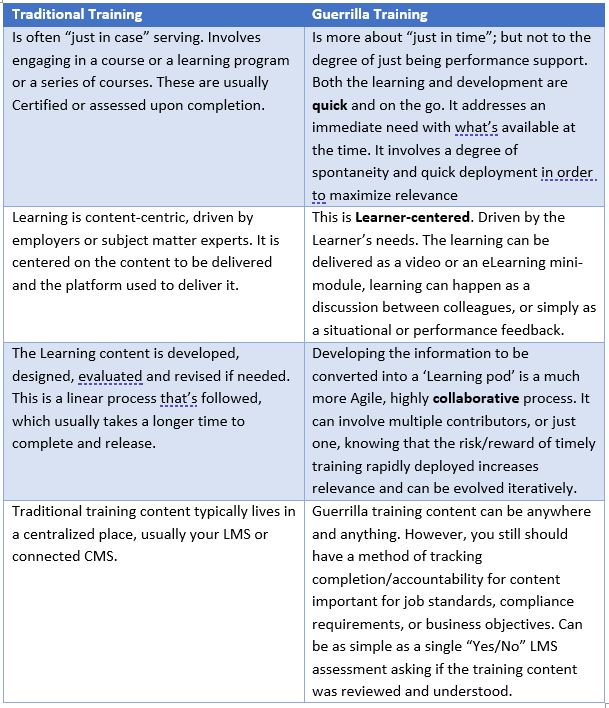Guerrilla Training – A Powerful Approach in Employee Training
The term “guerrilla” conjures images of soldiers slipping out from the cover of bushes or dropping out of trees to launch a surprise attack on a larger force. According to Wikipedia, “guerrilla warfare” is a form of irregular warfare in which small groups of combatants, such as paramilitary personnel, armed civilians, or irregulars, use military tactics including ambushes, sabotage, raids, petty warfare, hit-and-run tactics, and mobility, to fight a larger and less-mobile traditional military.” While we tend to think of guerrilla warfare as a late 20th century tactic, history shows that the approach has been used as far back as Sun Tzu in 6th century BC!
Nice history lesson but what does guerrilla warfare have to do with training? Think about the concept of small groups using tactics and a strategic approach, but with agility and reactiveness difficult for a larger more traditional force. We can use that concept in training – taking defensive and offensive actions based on what’s happening by the minute! Guerrilla training can be created by a training professional, sure, but just like guerrilla combatants can be a mix of soldiers and civilians, guerrilla training can also be accomplished by a leader, co-worker, subject expert, or external source.
Don’t confuse guerrilla training with guerrilla learning. You already use guerrilla learning all the time. For example, if you want to cook something you haven’t made before what do you do? Most likely you look it up online! Find a recipe that fits your pantry and get cooking. Unknown to you, you just used guerrilla tactics to help you. You didn’t go to a formal class or read a traditional cookbook. No, you faced a situation, determined a quick and efficient method to learn what information you need, and acted immediately on that information.
The flip side of guerrilla learning is guerrilla training. Devising a way to quickly provide the information needed to achieve a goal. Guerrilla training content can be shared using the organization’s learning platform (ideally a collaborative LMS such as Udutu), on social media, or simply by uploading a video to YouTube, Vimeo, or an internal video platform.
So, what is the difference between traditional training and guerrilla training?

Incorporating guerrilla training concept in your L&D strategy
You can incorporate guerrilla training in your online, on-demand training and L&D strategy through three simple steps.
Step 1 – Let current needs drive priorities. Employees in most organizations aren’t shy about what they need. They will tell you or their reporting manager what they wish to be trained on. Managers will know of many training needs that ‘really should be done someday’ but that never make it up the list of priorities. What offers immediate value? Changing behaviors, refining processes, removing risks/compliance issues, improving performance, eliminating “I didn’t know” as much as possible. Identify training needs not currently met by the existing training programs.
Step 2 – Collaborate and empower: Making sure folks understand and support the guerrilla training concept helps ensure the collaborative process is smooth. Keep all departments and management levels in your organization in the loop. Celebrate great examples and guide not so great initiatives on how to improve without shutting down the opportunities for guerrilla training. Get your internal clients, partners, and team to buy in to the idea of guerrilla training, perhaps by showing them how easy it is to design simple eLearning courses with today’s tools. Owing to the versatility of guerrilla training, it can be delivered in any format. As video, checklists, whiteboard reminders, door-knob hangers, memes, cartoon strips, social media posts… you get the idea. Guerrilla training isn’t about the medium but the message and objectives. Why, it could even come in the form of a blog (hint hint)!
Step 3 – Get it out there and track results: Publishing and repurposing learning content is traditionally a lengthy process, but when launching a guerrilla training module, the process is much quicker. The activity development practice can be viewed as being Agile. Use a robust, easy to access (cloud-based?) solution that anyone in the team can access with little or no budget. Something that will allow to you collaborate and create your learning activities with just a PPT, a PDF, a video, pictures or even just an anecdote with a relevant outcome. Of course, you can always use other platforms as well… even something as simple as email. The advantage of using these web-based authoring tools is that, with very little technical expertise, just about anyone can create actual training activities, even with assessments, in near real-time. Again, it can be as simple as an email read receipt or some other acknowledgement that the participant reviewed the content and understood it but, ideally, it should be tracked in some way. An easy to implement LMS is going to be an ideal solution.
Using guerrilla training approach for employee training – an example
So, let’s pose a hypothetical situation and consider how we could use guerrilla training to address it. If your organization is a grocery store, for instance, how employees handle a particular seasonal fruit may be unique. The wastage from poor handling is costing you money and despite mentioning the concern to your team, it still continues. How about you create a video showing step by step instructions as performed by the manager or another employee on the job? How about just pictures even? The media can be captured on the spot, using your phone camera. It can then be added as an optional mini-module or even an addition to an existing activity already teaching produce topics. Either way, a short assessment – maybe just a few multiple-choice questions – will help ensure that the outcomes intended from this were understood. With the right solutions, everything including the actual delivery and tracking of the activity, could be done quickly, easily, and affordably by anyone on the team in just a few hours.
Alrighty then, let’s sum it up. The essence of guerrilla training is that it is quick, format agnostic, and focused on the most immediate training needs. It’s Agile, creative and opportunistic. It’s brave – possibly to a fault. Mistakes might be made but quick solutions, pivots and reattempts are executed. When you use guerilla training, you establish continuous learning and truly create a continual learning culture in your organization, giving everyone a chance to maintain momentum in learning. You most likely improve employee performance, employee retention, customer satisfaction, and your bottom line and you most certainly learn a thing or two about your team in the process! That, my friends, is guerrilla training and it’s something that will help any size organization win the battles that make up the war! …..too agro??? 😊





